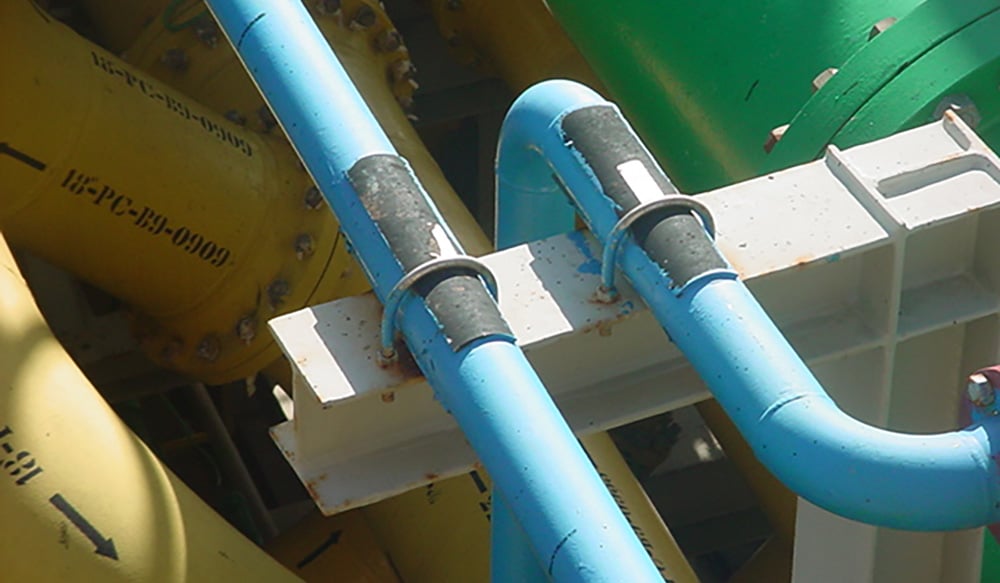
You probably already know how important it is to use quality pipe supports in your process piping system. But what does that mean? When you’re picking out the best supports for your system, how do you know the difference between quality products and underperformers?
We’re here to help. We’ve nailed the five things that great pipe supports do and how to spot them:
1. Pipe supports should shield pipes from metal-to-metal contact.
What’s so bad about metal-on-metal contact? After all, metal is supposed to be durable, right? The problem is that when metals rub against one another, it’s destructive.
One of the most common problems with metal-to-metal contact is galvanic corrosion. Not all metals get along when they’re in physical contact with one another. Under the right circumstances, contact between dissimilar metals will kick off an electrochemical reaction and end up rusting one of the metals. A quality support will avoid this corrosion.
Great supports offer two tactics for stopping galvanic corrosion. First, they may incorporate non-metallic liners or pieces that physically separate metal parts. These insulators stop the metal of the support from touching the metal of the pipe.
However, even if the metals are physically touching, quality supports will still protect against corrosion. Metallic supports can incorporate coatings and finishes that protect metal. For instance, you can galvanize metallic pipe supports, which will add a layer of zinc to your pipe support and maintain the integrity of the original metal.
2. They protect against the rough abrasion of pipe movement.
Anyone who’s run a fingernail down a chalkboard understands how movement can lead to scraping, abrasion, and damage. Simply put, friction-heavy objects rubbing up against one another causes destruction. In piping systems, the same deterioration happens when pipes rub up against other metals or concrete surfaces.
As stable as your pipes may appear to be, they are probably still susceptible to some type of movement. Everything from subtle shifts and jolts to heavier vibrations and thermal expansion can cause pipes to grind across unprotected surfaces.
Quality pipe supports will encourage the right kind of pipe movement and reduce destructive action. This may mean keeping pipes from bouncing or sliding from side to side while allowing them to move axially.
3. They perform under high compressive loads.
Pipes can be extremely heavy and forceful, and so the brunt of their weight has to go somewhere. Much of the time, that “somewhere” is a pipe support.
Quality pipe supports will have a high compressive strength. Compressive strength dictates how much weight a support can handle before its performance suffers. The value here is easy to see. If a pipe support can’t uphold the weight of a piping system, it could collapse and wreck the whole system.
This is especially important for load-bearing pipe supports like pipe shoes and slide plates. If they aren’t able to perform under heavy pressure, it can not only disrupt the system, but it can also damage pipes or cause ruptures.
4. They hold up in harsh environmental conditions.
Pipes are up against rough conditions. They carry corrosive materials like oil, gas, and chemicals. They’re exposed to extreme hot and cold. They’re out in salt-heavy or wet environments. Pipe supports need to withstand these same elements and help pipes thrive in them.
In turn, quality pipe supports will be designed to hold up in the right conditions. This may mean ensuring that a support’s makeup is geared toward protecting against high heat, frigid temperatures, and chemicals, as well as stopping heat transfer, discouraging ice formation, and helping pipes avoid pitting corrosion.
5. They provide a low coefficient of friction.
When you dive onto a wet slip-and-slide, you will glide across the lawn. But if you dive onto wet concrete, you’ll come to a sharp stop, tearing your skin in the process. Why is that?
The answer is your coefficient of friction, and having a low coefficient of friction is an important quality to look for in a well-made pipe support. Simply put, coefficient of friction is a way to calculate friction. It accounts for both the friction between two objects and the force that’s pressing them together.
In piping, a simple example of a product with a low coefficient of friction is the Protek U-Bolt. It’s a U-bolt, and so its bare metal surface would normally rub directly against metal pipes. However, in this case, the support includes a thermoplastic coating that gives it a low coefficient of friction. This makes it easier for pipes to move axially and avoid damage.
In the same way, quality pipe supports reduce friction and use forces to encourage more natural pipe movement.
More on pipe supports ...
As you’re picking out pipe supports for your system, make sure that the products are meeting a higher standard. This will help you lengthen the lifespan of your system and improve how your pipes perform.
Want to learn more about how different supports can improve your piping system? Read The Complete Guide to Pipe Restraints.





